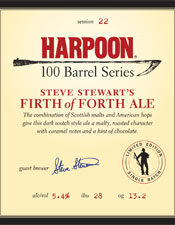If there's one word that just screams "Amer'can" (three-syllables), it's Budweiser. For decades, the name has defined not only beer, but a way of life. If you are a "Bud Man," chances are you are a patriotic, blue-collar guy, who likes to work hard and relax at the end of the day with a cold one. Chances are you drink it directly out of the can or bottle, and drink it partially because you want to support Amer'ca and Amer'can workers -- at least up until six months ago.
This is the stereotype, anyway. For most people, Bud is a shorthand for affordable, universally-accepted beer that you could bring to a party without risk. It is the Coca-Cola of American beer; it's a wonder they still even feel the need to advertise.
Because of this, the unveiling of Bud American Ale has been met with curiosity and skepticism. I'm not sure how long Bud had been planning on unveiling this product, but it has put its weight behind it. Skeptics would say that Bud is attempting to tap into the craft beer market by creating a beer with a reddish hue that will somehow crossover by luring in the frugal craft beer fan, as well as the loyal -- if curious -- Budweiser aficianado.
So is this a cynical attempt to tap into the burgeoning craft beer market? Or is it an earnest olive branch to the evolving American palate? I took a flier a 22-oz bottle to find out.
First, let's observe the appearance: yellow water it is not. Although it is see-through (I was able to watch a few scenes of "30 Rock" completely through the glass), it is a nice reddish-orange color. The head is relatively sturdy -- another surprise. At face value, the look is not bad at all.
 The aroma is relatively inoffensive as well. The caramel malts to which they refer in the commercials are noticeable, in their slightly toasted smell. It is sweeter in the nose than I had expected it to be, mostly because I had expected an English pub ale by its appearance. There is a little bit of a tinny, metallic presence here, which is typical of a macro beer. Some mild grassy hops are a minor accent, and some extra sweetness comes through in some brown sugary notes.
The aroma is relatively inoffensive as well. The caramel malts to which they refer in the commercials are noticeable, in their slightly toasted smell. It is sweeter in the nose than I had expected it to be, mostly because I had expected an English pub ale by its appearance. There is a little bit of a tinny, metallic presence here, which is typical of a macro beer. Some mild grassy hops are a minor accent, and some extra sweetness comes through in some brown sugary notes.
Finally, time to take a sip. The first thing I notice is how sweet it is, with more of that brown sugar coming through, but more of a sweet toffee flavor. It's actually too sweet for me, only because there is not enough of a hop balance.
I know that America is not ready for a steady diet of hops in a macro beer, lager or ale. But it appears to me that if Bud is truly committed to making a craft beer -- as opposed to simply cracking into the craft beer market -- they need to start adding some hops for balance. Sure, it may hinder sales among the fratboy crowd, but it might actually convince craft beer drinkers to give it a chance when they are looking for a cheap, widely-available ale. As-is, it's like Bass with a more cloyingly sweet, unbalanced flavor.
It does feel creamier than any Bud product I've ever had, but that's not saying much. It's drinkable, but it's weak. Far too cloying in both its sugary sweetness and its overbearing alcohol, which should have been hidden by more richness.
It seems that Bud may have suffered from trying to straddle the line between wanting to make something that would entice ale-drinkers, but not offend their hardcore contingent (i.e. 50% of the American beer-drinking population). Unfortunately, I think they may have failed at both.
My hope is that the American Ale will find a way to infiltrate the masses, thereby allowing the populace's palate to change from bland macro lagers to something more rich and flavorful. (For all its flaws, American Ale is far more flavorful than any of it's Bud brethren.) This, in my utopia, would lead to more ale-drinkers, who would then branch out into other beers and breweries.
Of course, I'm sure the folks at Bud don't share this hope.
Budweiser American Ale is a below-average but inoffensive ale. It reminds me of a sports bar more than a pub. And whether Bud should be lauded for branching out or scolded for being opportunistic and exploitative, I'll leave that up to you.
























